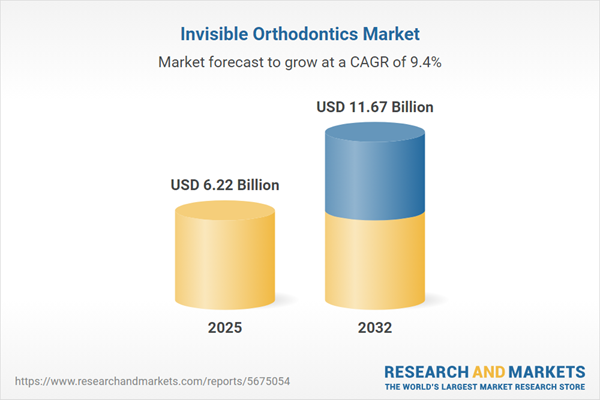Speak directly to the analyst to clarify any post sales queries you may have.
The invisible orthodontics market delivers innovative, patient-focused dental correction solutions driven by digital transformation and growing preferences for minimally visible devices. Industry stakeholders are leveraging advanced technologies and evolving workflows to maintain momentum and capitalize on rising global demand.
Market Snapshot: Invisible Orthodontics Market Growth Outlook
The Invisible Orthodontics Market grew from USD 5.69 billion in 2024 to USD 6.22 billion in 2025. It is expected to continue growing at a CAGR of 9.39%, reaching USD 11.67 billion by 2032. The market’s expansion reflects a long-term trend toward discreet dental treatments, underpinned by continual advances in materials science and digital workflow integration. This robust performance showcases sustained investment and adoption across key regions, supported by an increasingly diverse customer base and a broadening range of applications.
Scope & Segmentation: Comprehensive Coverage Across Product Types and Global Regions
- Product Types: Fixed ceramic braces (monocrystalline, polycrystalline), metal braces, self-ligating brackets, lingual braces, clear aligners, smart aligners.
- Distribution Channels: Dental clinics (group, private), hospitals, online channels (B2B platforms, direct to consumer), retail pharmacies.
- End Users: Dental clinics, dental laboratories, hospitals, orthodontists (group and private practices).
- Material Types: Polyethylene terephthalate glycol, polyurethane, thermoplastics and other advanced polymers.
- Technologies: CAD/CAM systems, three-dimensional printing.
- Age Groups: Adults, teenagers, children.
- Regional Coverage: Americas (North America, Latin America), Europe, Middle East & Africa, Asia-Pacific.
- Company Analysis: Align Technology, SmileDirectClub, Straumann Holding, Dentsply Sirona, 3M, Envista Holdings, Angelalign Technology, Eon3Dental, Byte USA, ClearCorrect.
Key Takeaways for Senior Decision-Makers
- Enhanced digital workflows support streamlined diagnosis, treatment planning, and ongoing case management, leading to higher patient satisfaction.
- Adoption of smart materials ensures devices blend comfort, flexibility, and predictable force delivery, reducing manual adjustment requirements and operator variability.
- AI-driven algorithms and remote monitoring improve clinical accuracy, optimize treatment timeframes, and enable practitioners to offer virtual consultations with reduced in-person visits.
- Material science breakthroughs and additive manufacturing enable cost-effective, personalized products that address complex malocclusion cases with greater precision.
- Regional market performance varies, with North America and Western Europe leading innovation, while Asia-Pacific and selected EMEA countries show rapid uptake fueled by digital health investments and regulatory harmonization.
- Collaborations across manufacturers, software developers, and providers foster scalable ecosystems, supporting both direct-to-consumer and traditional clinical models.
Tariff Impact: Navigating Evolving Cost Structures and Supply Chains
Recent US tariff measures on imported thermoplastics and precision components are reshaping procurement strategies and supply chain design. Manufacturers are mitigating risk through local sourcing, renegotiated supplier contracts, and nearshoring. These adjustments drive greater end-to-end agility and resilience, enabling operational continuity and margin protection in a volatile trade environment. Distributors are adapting pricing models and route-to-market strategies to preserve customer loyalty and absorb cost fluctuations where possible.
Methodology & Data Sources
This report applies a multi-pronged research approach, including in-depth interviews with orthodontic specialists, dental lab leaders, and supply chain executives. Secondary data is triangulated through review of industry reports, regulatory filings, and patent databases. Rigorous validation—including analytical peer review and statistical checks—ensures all findings meet the highest standards for business decision-making.
Why This Report Matters
- Empowers senior leaders to anticipate shifts in supply chain costs, regulatory impacts, and digital adoption curves within the invisible orthodontics segment.
- Provides actionable segmentation insights to prioritize product development, regional investments, and strategic partnerships supporting competitive growth.
- Supports risk mitigation planning by highlighting the influence of tariffs and supply-side factors on operational strategies.
Conclusion
The invisible orthodontics market continues to advance via innovation, strategic collaborations, and technology adoption. Decision-makers equipped with granular intelligence on key segments and evolving trade dynamics can identify emerging opportunities and build long-term value in this dynamic sector.
Additional Product Information:
- Purchase of this report includes 1 year online access with quarterly updates.
- This report can be updated on request. Please contact our Customer Experience team using the Ask a Question widget on our website.
Table of Contents
3. Executive Summary
4. Market Overview
7. Cumulative Impact of Artificial Intelligence 2025
Companies Mentioned
The companies profiled in this Invisible Orthodontics market report include:- Align Technology, Inc.
- SmileDirectClub, Inc.
- Straumann Holding AG
- Dentsply Sirona Inc.
- 3M Company
- Envista Holdings Corporation
- Angelalign Technology Inc.
- Eon3Dental Inc.
- Byte USA, Inc.
- ClearCorrect, LLC
Table Information
| Report Attribute | Details |
|---|---|
| No. of Pages | 191 |
| Published | November 2025 |
| Forecast Period | 2025 - 2032 |
| Estimated Market Value ( USD | $ 6.22 Billion |
| Forecasted Market Value ( USD | $ 11.67 Billion |
| Compound Annual Growth Rate | 9.3% |
| Regions Covered | Global |
| No. of Companies Mentioned | 11 |









